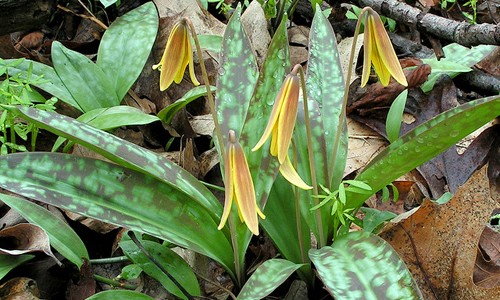Trout lilies are in the Erythronium genus along with 30 other species of flowers. They grow in temperate forests and meadows throughout the Northern Hemisphere, typically flowering in the spring. They can vary greatly in flower color, but they tend to have a six petal flower with a speckled center, two oblong leaves with brown speckles, a lower stem with reddish color, and a root bulb that looks similar to a dog’s canine tooth (which is why some species are known as dog’s-tooth violets). These flowers can be a real sight for sore eyes to anyone surviving in the wilderness, not only are they beautiful, they are edible.
- They are usually found in groups, so if you only see one, move the surrounding grass or fallen leaves to determine if there are more.
- The flowers have a sweet taste and can be eaten raw. They will taste best if you eat them right when you find them rather than waiting until you have harvested enough bulbs to take back to camp since they will wilt.
- The leaves can be eaten raw or boiled.
- The root bulb will be the most valuable portion of the plant to a wilderness survivor since it offers carbohydrates and protein. After removing the paper-like hull, it can be eaten raw, dried, or cooked. The taste is like an earthy cucumber crossed with a potato.
- They do not grow as quickly as some wild edibles so they should not be harvested in mass to satisfy curiosity when hiking or camping. Pulling up one or two shouldn’t hurt their numbers next year and will be enough to give you an idea of their characteristics.
Since they only produce two leaves when fully mature, and a small root bulb, trout lilies are not going to provide you with a bounty, but survivors can’t be choosers and they will give you enough to keep you going until your next meal.
If you liked this, you might also enjoy…


